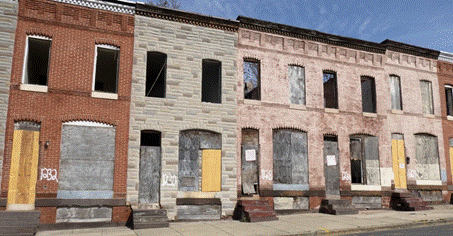
Photo credit: https://www.governing.com/community/once-again-baltimore-hopes-to-fight-blight-with-1-homes
Treat the Cause, Not the Symptoms
Anyone who travels around Baltimore City will see plenty of abandoned, decaying houses. Estimates usually put the count at 16,000, but no one knows for sure. And the number is probably growing: as fast as the city can take possession of tax-delinquent properties and knock them down, more owners simply check out. Census estimates show the city is losing almost 600 residents per month.
That so many Baltimoreans have decided their real estate holdings are worthless is shocking, really. For that to be true, the costs of maintaining ownership of their property – upkeep, taxes, etc. – must exceed the benefits – their value of living there, or the rent they could charge someone else to do so. It’s an incredibly sad commentary on the condition of our fair city that that inequality holds true so widely, and, thus, so many property owners are walking away rather than staying and rebuilding Baltimore.
Now comes the latest plan to mitigate this problem: it’s branded as a "land bank" – a feel-good phrase, but one that’s not very descriptive. More precisely, the plan is for a new, improved bureaucracy, the function of which will be to accelerate the city’s acquisition of abandoned properties, clear their debts, piece together developable tracts, and sell them to developers.
The idea faces resistance in the City Council – legislation introduced last March has yet to get a hearing – because there’s already a city bureau charged with this task: the Department of Housing and Community Development (DHCD). The official line is that DHCD does everything the proposed land bank would do – and then some – and does it “holistically.”
The visible evidence suggests otherwise, of course. But there’s little sentiment to take budget dollars away from DHCD and use them to create a new bureau. Maybe City Hall understands that there’s little reason to hope that a new agency will be more efficient than the old one. Or maybe officials reflexively defend the status quo because they always see diagnosis of a problem as personal criticism.
No matter. Even if a new agency was run by saintly geniuses, even if better government middlemen actually accelerated what needs accelerating, it would leave the root cause of abandonment untreated. It would be mere symptomatic relief rather than a cure for the city’s disinvestment crisis.
To understand this, we need to do some basic arithmetic related to cost and value. Bear with me.
According to this Forbes piece, it costs a little under $300,000 to build a home in Maryland these days, or about $150 per square foot for a 2,000 s.f. home. Let’s go with that – though some estimates put costs of more modest homes at $100/s.f., and many people can do with a smaller dwelling.
If I have a decayed property that’s currently worthless in Baltimore City and I’m thinking of abandoning it (i.e., stopping my tax payments and neither inhabiting it nor renting it out), the alternative might be calling in a contractor and investing the aforementioned amount. I may not have that on hand, of course, but suppose I can borrow it and go ahead with my own little urban renewal plan.
Suppose further that the Maryland Department of Assessments and Taxation will come along and say “hey, great – you built a $300,000 house here. That’s the assessed value of the ‘improvement’ on which your local property tax bill will be based.”
In Baltimore City, at current interest rates (7%!), that investment implies a monthly principal-interest-taxes bill of $2,615. If you don’t value the amenity of your home and neighborhood or the services provided by city government more than that, you won’t invest – you’ll abandon ship… er, house.
Of course, there are several factors weighing down the value side of the equation in Baltimore City: unsafe streets, poor schools, etc. We should all work to make city life more highly valued. No question about it. But that’s not all we need to do; there’s another problem that needs to be solved as well.
Continue the investment arithmetic: no more than four or five miles away from any city property, a better investment climate beckons. Invest that $300,000 in a property in Baltimore County, with a property tax rate less than half the city’s, and your monthly P+I+T bill will be just $2,270, 13% less than in the city.
Even if all else is the same (amenity, safety, school quality, etc.), this is a no brainer: investment will flow to the county rather than the city. Abandonment will be common in the city; rare in the superior investment climate. And, as we’ve already noted, all else is not the same in many city neighborhoods.
The bottom line here is that a competitive property tax rate in Baltimore City is a necessary condition for its revival. No, it is not a sufficient condition; we need to work on our other problems, too. But if this one is not addressed sensibly, along the lines MPPI has long recommended, then all our other efforts may come to naught. Programs like a “land bank” are like giving pain reliever to someone with a broken limb. Our investment climate is, in fact, broken; we need more than symptomatic relief.
Stephen J.K. Walters is Chief Economist at the Maryland Public Policy Institute and author of Boom Towns: Restoring the Urban American Dream.





